Gilgo Beach serial killing suspect's wife files for divorce
Fox Nation host Nancy Grace joins 'America's Newsroom' to discuss the ongoing search at Rex Heuermann's home and his wife's decision to file for divorce.
The case against accused Long Island serial killer Rex Heuermann hinges largely on extensive cellphone evidence — including burner phones he thought would conceal his identity when contacting victims.
However, the New York architect’s efforts to remain anonymous unraveled in the face of advanced technology and common myths about the detectability of the devices, experts told Fox News Digital.
"The more you use the phone, the more there’s a pattern and patterns are what catch you," said Frank Thornton of Blackthorn Digital Forensics.
Heuermann, 59, was arrested last Thursday for the murders of Megan Waterman, 22, Amber Costello, 27 and Melissa Barthelemy, 24, whose cellphone he allegedly used to make taunting phone calls to her sister.
ACCUSED GILGO BEACH KILLER NICKNAMED PETER FROM ‘FAMILY GUY’ BY CO-WORKERS: SOURCE

Accused Long Island killer Rex Heuermann, center. In the background is Gilgo Beach, where the bodies of his four suspected victims were found in 2010. (Jeffrey Simon Architecture & Design/Mega)
The married father of two is also the prime suspect in the slaying of a fourth victim, Maureen Brainard-Barnes, 25. The petite women were all sex workers who advertised on Craigslist.
Their bound bodies were discovered within two days of each other in 2010 on a stretch of New York's Gilgo Beach, but it would take investigators more than 12 years to find their alleged killer.
Burner phones
Burner phones, also known as track phones, are inexpensive cellphones that do not require identity verification or credit checks.
They are often used by criminals to disguise illegal activity and by people who cannot afford more expensive contracts.
SUSPECTED LONG ISLAND SERIAL KILLER'S DUCK HUNTING COULD HAVE BEEN PERFECT COVER FOR HIDING BODIES
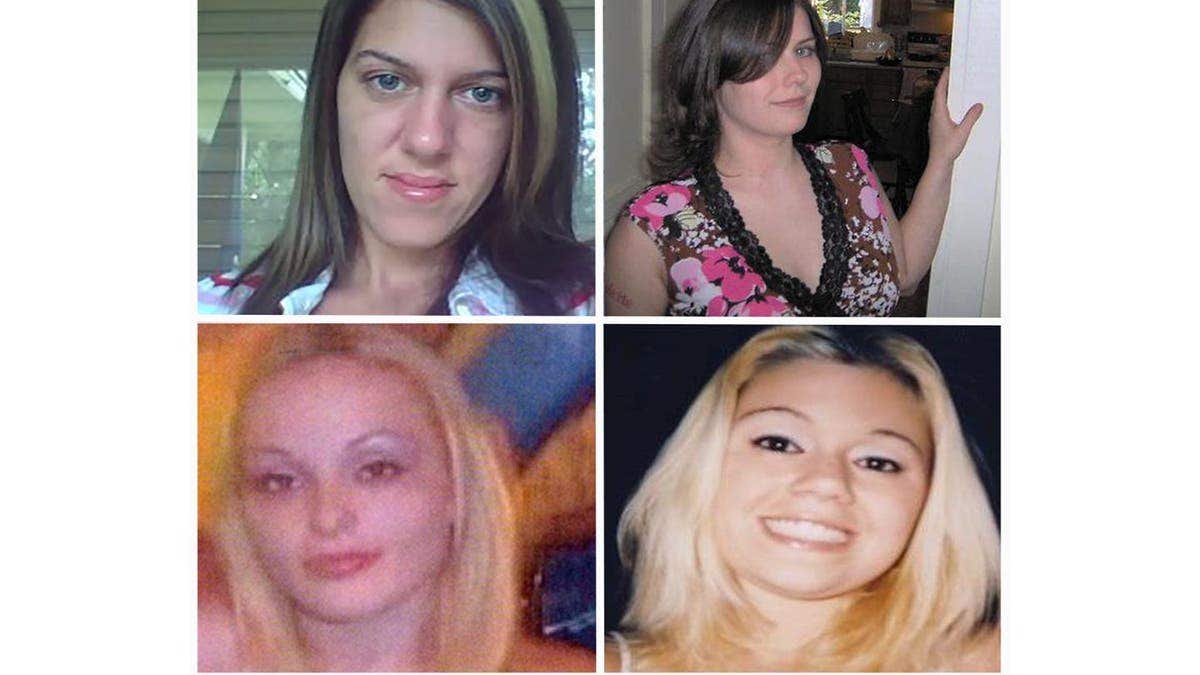
Gilgo Beach murder victims Amber Costello, top left, Maureen Brainard-Barnes, top right, Melissa Barthelemy, bottom left, and Megan Waterman. (Suffolk County Police Department)
Heuermann allegedly used a different burner phone to communicate with each of his victims before they disappeared between July 2007 and September 2010.
"I think he thought he was anonymous behind a burner phone and didn’t think about things like the repetitious use showing up as a pattern," Thornton told Fox News Digital.
"It would have been much harder to put any of this together, had he immediately thrown out the burner phones after each use," he added.
Even though a burner phone may not be tied to a particular person, it still has an identifier and is tracked on a cellular network, technology expert Vaibhav Gupta explained.
Whenever a call is placed, the details are recorded by the service provider. Specifically, a cellphone pings off the nearest tower based on distance, signal strength and other factors. As the cellphone moves, the tower that it connects to changes.
Cellphone companies typically retain this data for a few months to a few years.
"People think burner phones are untraceable," said Micah Sturgis, director of Digital Forensic Services for Barefoot Professional Investigations in North Carolina. "If you open it up over free Wi-Fi at McDonald’s, it’s going to show you at McDonald’s on that date and time, and you’re probably on surveillance."
Alleged killer leaves clues in cellphone data
After the women disappeared, investigators obtained cell site dumps, which contain information on all the devices that connected to specific cell towers during a period of time relevant to the victims’ movements.
GILGO BEACH MURDERS: THE INVESTIGATION IN PHOTOS
This data was not obtained after Brainard-Barnes vanished July 9, 2007.
The FBI compared the victims’ phones with the burner phones and the towers they were pinging off of.
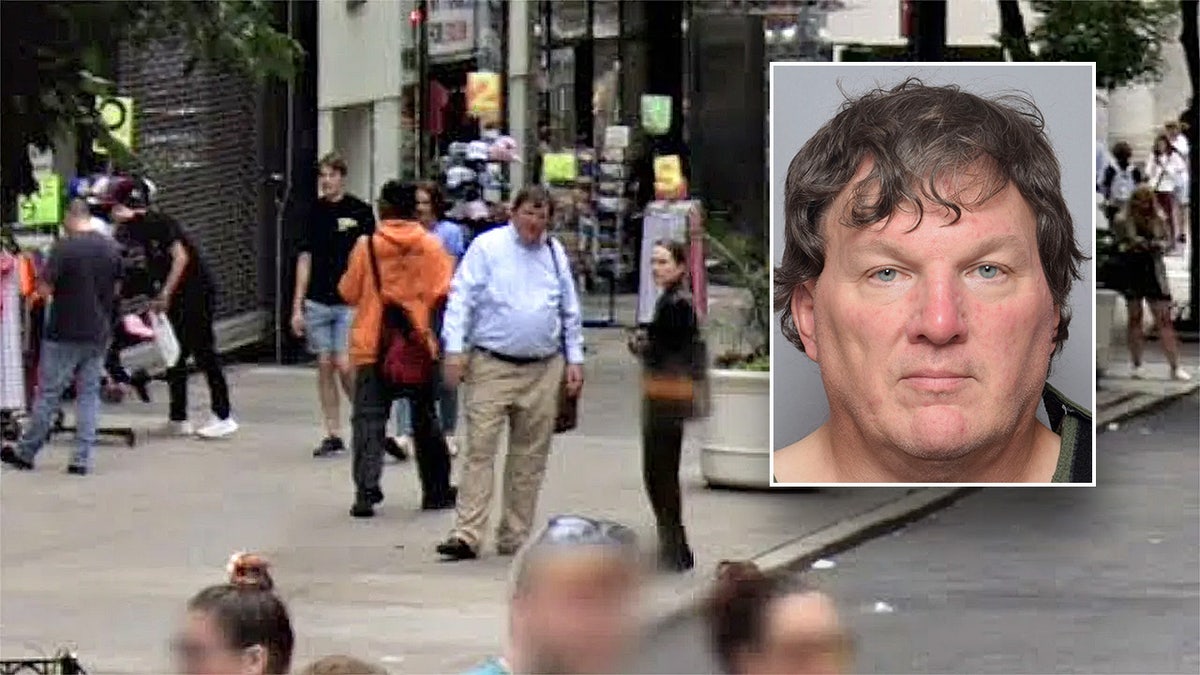
Accused Gilgo Beach serial killer Rex Heuermann was captured on Google street view images months before his arrest in Midtown Manhattan. (Google Maps/Suffolk County Sheriff's Office)
They honed in on a section of Midtown Manhattan and the bedroom community of Massapequa Park, New York, about 40 miles east of the city and about 15 miles north of Gilgo Beach.
However, narrowing the perimeter in a major metropolis like Manhattan, Sturgis said, is all but useless. While police preserved the data, there was little more they could do with it at the time.
WATCH 'GRIM TIDE' ON FOX NATION
Immediately after assuming office in January 2022, Suffolk County District Attorney Ray Tierney announced the creation of a new task force, which included the FBI, to solve what became known as the "Gilgo Four."
In a little over two months, the team identified a suspect using information they had gleaned in 2010.
The Chevrolet Avalanche
The day before Costello vanished, she exchanged messages with a man in Massapequa Park using a burner phone.
The client traveled to her home in West Babylon, Long Island, on Sept. 1 for a date, but a man, pretending to be Costello’s outraged boyfriend, stormed in. The rattled client left after he had already paid.
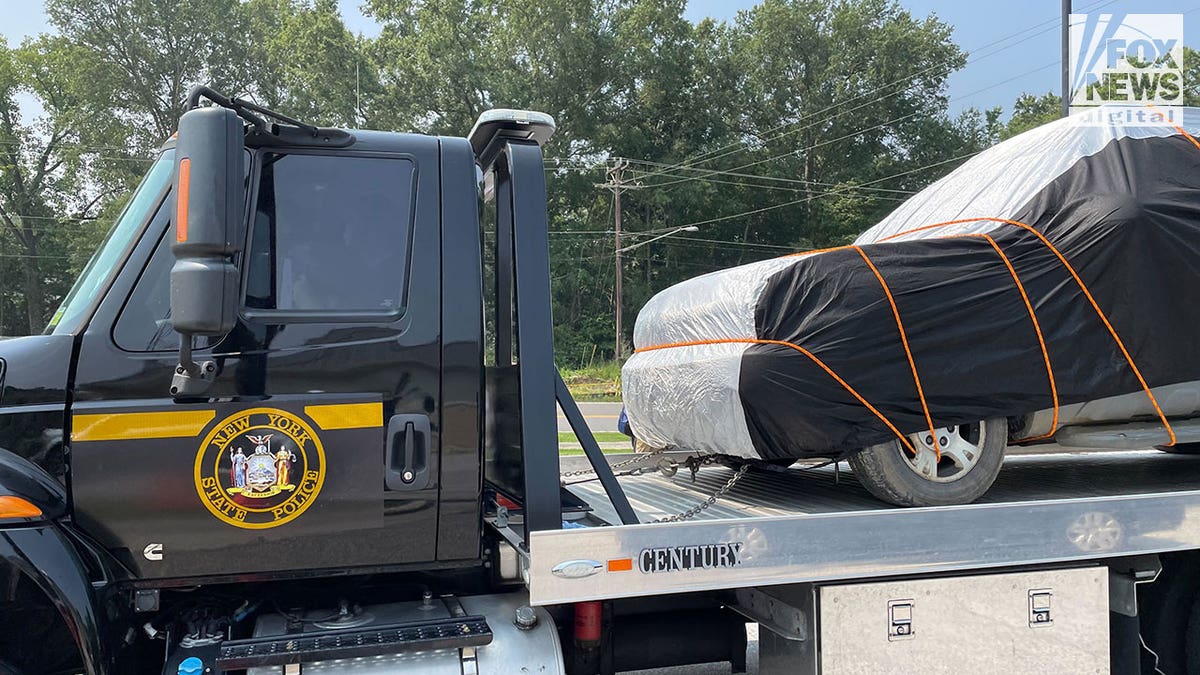
New York State Police tow a Chevy Avalanche in South Carolina in connection to Gilgo Beach murder suspect Rex Heuermann. (Audrey Conklin/Fox News Digital)
A witness described the john’s car as a dark-colored first-generation Chevrolet Avalanche with a "very unique feature" between the cab and the bed, Tierney said at a press conference announcing the arrest Friday.
In addition, the witness described the man as in his mid-40s, over 6 feet-4 inches tall and wearing "big oval style 1970s type eyeglasses."'
ACCUSED GILGO BEACH KILLER REX HEUERMANN SEEN IN EERIE GOOGLE STREET VIEW IMAGES
The next evening the same man picked up Costello in the Avalanche, according to a witness, and she was never seen again.
For the first time in January 2022, a New York State investigator searched a database for that specific car registered to a driver that matched the 2010 description, which led them to Heuermann.

Asa Ellerup, wife of accused Gilgo Beach killer Rex Heuermann, and their daughter Victoria Heuermann walk through a parking lot Tuesday, July 18, 2023. (Dario Alequin for Fox News Digital )
He not only lived in Massapequa Park, but he worked in Midtown Manhattan. His wife was also out of town when Barthelemy, Waterman and Costello disappeared. The clues were rapidly aligning.
How police connect Heuermann to the burner phones
Although location data for Heuermann’s cellphone is long gone, any activity that overlapped with the original data dumps is likely preserved, Gupta said.
"It’s a massive amount of data analysis that has to be done," said former FBI agent and criminal profiler Jim Clemente. "Even 10 years ago, it would have taken so many more computers to do what we can do now to sift through data and see patterns that were just all background noise before."
It turned out the movements of Heuermann’s cellphone matched up on numerous occasions with those of the victims and the burner phones, along with his Amex purchases.
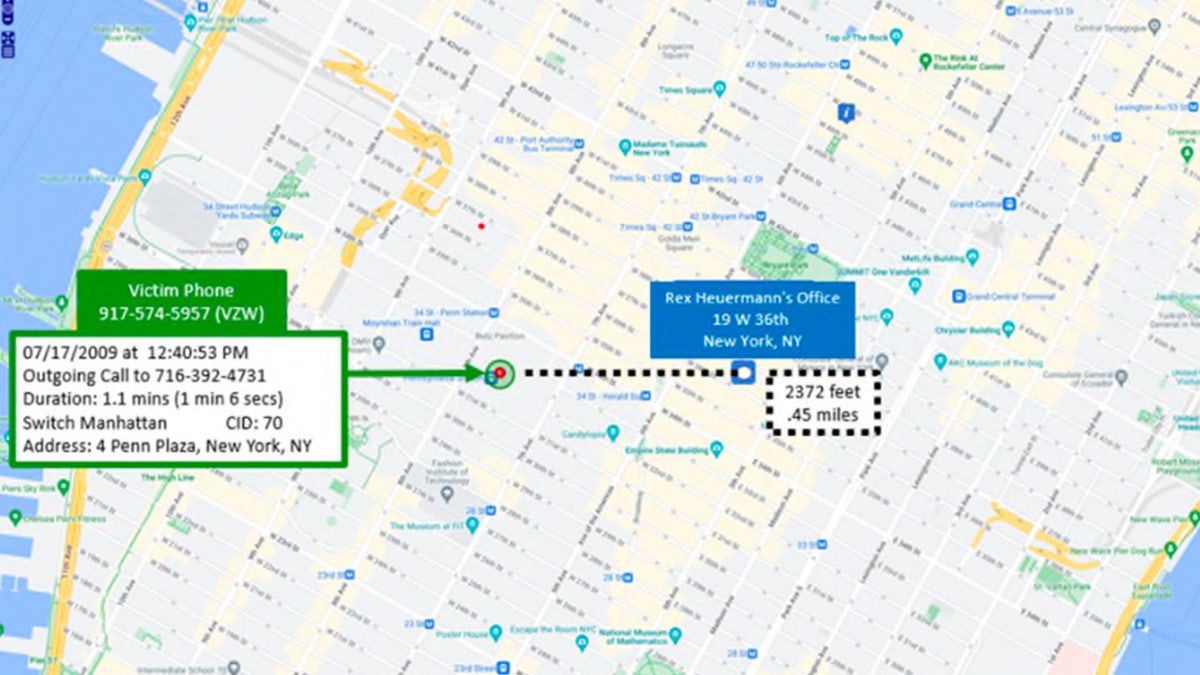
Rex Heuermann allegedly called victim Melissa Barthelemy's sister, seven days after she disappeared, from her own cellphone, which pinged off a tower 2,372 feet from his Midtown office. It was one of several calls he allegedly placed on the victim's phone. (Suffolk County District Attorney's Office)
Even more telling, "investigators could find no instance where Heuermann was in a separate location from these other cellphones," prosecutors wrote in a bail application.
For example, the day Barthelemy was last seen alive on July 10, 2009, the burner phone used to call her and Heuermann’s cellphone were in Massapequa and traveled together to New York City.
"Thereafter, both Ms. Barthelemy and Heuermann’s phone traveled eastbound toward Massapequa," the bail application says.
Heuermann repeatedly used Barthelemy’s phone to call and terrorize her family, and each time it pinged off a tower near his office, authorities said. He also allegedly used Barthelemy and Brainard-Barnes’ phones to check their voicemails after they were murdered.

Rex Heuermann allegedly searched "Long Island Serial Killer" on a Google account connected to a burner phone in March 2022. It was one of many occasions he looked up the case and his victims, according to police. (Suffolk County District Attorney)
Clemente said that Heuermann "took a tremendous risk" by using the victims’ phones but called him a "sexual sadist" who couldn’t control his impulses.
When Heuermann allegedly told Barthelemy’s sister what he did to the young woman, he "got off on causing and witnessing her pain and fear" and reliving his crime, Clemente said.
GILGO BEACH MURDERS: 3 SERIAL KILLERS WHO LIVED MUNDANE LIVES HID DARK TRUTH
"It’s similar to an arsonist watching the reaction of the fire department and the flames and having that feeling of power," he said.
As the probe of Heuermann deepened, investigators located additional burner phones he had allegedly used to troll for prostitutes and create email accounts to look up hours of torture and child pornography.
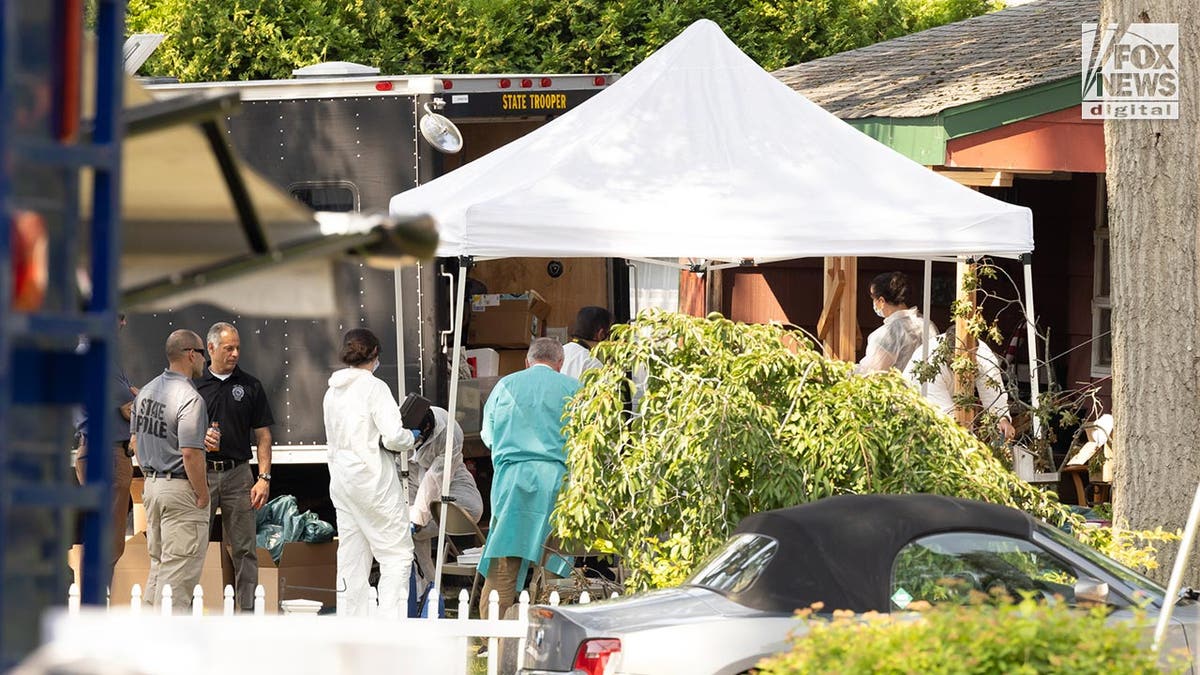
Police remove items from the home of Rex Heuermann in Massapequa Park, New York, Thursday, July 20, 2023. Heuermann is charged with murdering three sex workers whose bodies were discovered in Gilgo Beach, Long Island, in 2010. (Mega for Fox News Digital)
He also allegedly looked up his victims, their families and the task force that was investigating him as late as June 2023.
CLICK HERE TO GET THE FOX NEWS APP
Perhaps he felt the walls closing in. He had accessed a 2021 Fox News Digital article titled, "In Long Island serial killer investigation, new phone technology may be key to break in case."






















